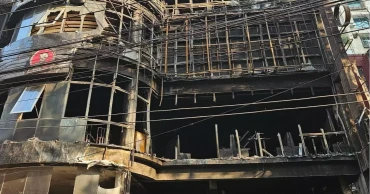Bailey Road fire
Bailey Road fire: Journalist Brishty buried in Kushtia
Journalist Brishty Khatun, a victim of the restaurant building fire on Bailey Road in the capital, has been buried beside her uncle’s grave at the family graveyard in Kushtia.
The ambulance carrying the body of Brishty reached her village home at Banagram Paschimpara of Ward No. 7 of Betbaria Union in Khoksa Upazila at 8:20 pm on Monday (March 11, 2024).
At that time, mourning relatives and villagers flocked to see her body.
Fire at kitchen market in Dhaka’s Uttara doused
Around 10 pm, it was announced through loudspeaker of a local mosque that her namaz-e-janaza will be held in the courtyard of her house. Hundreds of people of the village and nearby villages attended the janaza.
A close relative of Brishty named Rabiul Islam conducted the namaz-e-janaza. After the namaz-e-janaza, Brishty was buried beside the grave of his uncle Mubarak Sheikh in the presence of administrative officials.
Brishty, also known as Ovisruti Shastri to her colleagues at The Report Live, was among the 46 people who lost their lives in the deadly fire on February 29 night.
Bailey Road Tragedy: Brishty Khatun's body handed over to her family
Due to identity complications, the body of journalist Ovisruti Shastri alias Brishty Khatun was handed over her father Sabuj Sheikh from the morgue of Sheikh Hasina Burn and Plastic Surgery Institute on Monday afternoon, 11 days after the DNA test report of Brishty and her parents came.
1 year ago
Bailey Road Tragedy: Brishty Khatun's body handed over to her family
After confusion over the identity of a female journalist who was burnt to death in the devastating fire on Bailey Road on February 29, police finally confirmed her real name was Brishty Khatun, and she used a pen name Ovisruti Shastri.
The result came as the samples of her DNA matched those collected from her parents on Sunday, Additional DIG of Dhaka Metro CID Md Jahangir Hossain Matubbar confirmed.
Later on Monday afternoon, 11 days after the incident, the body was handed over to her father Sabuj Sheikh from the Dhaka Medical College morgue.
In response to a question from the journalists, Additional DIG said, the victim worked in various places using the name of Ovisruti Shastri. That's why confusion was created over her identity and her colleagues claimed she was Hindu. Later they understood and wrote to the police station, to hand over the dead body to her parents.
Read more: High Court issues rule on compensation for Bailey Road fire victims
Sabuj Sheikh said the truth has been established: “I am her father, I thank Allah thousands and millions.”
“Finally I received the body today, I will take it to my village home. There, she will be buried in the family cemetery with a Janaza according to Islamic Shari'a,” he added.
Brishty Khatun was the eldest among his three daughters.
Habibur Rahman, sub-inspector (SI) of Ramna Police Station, was present at that time.
After due procedures, at 2.55 pm, Sabuj Sheikh left Dhaka with Birshty’s body.
Read more: Why Fire Safety Audit is Essential for Commercial Buildings
1 year ago
‘Harassment in the name of crackdown’: Restaurant owners allege disarray in fire incident response
Following the devastating fire incident at the Green Cozy Cottage building on Bailey Road that killed 46 people and injured several others, authorities in Dhaka have launched a crackdown on restaurants lacking proper fire safety measures. Restaurant owners, however, are critical of the approach.
The Restaurant Owners Association has labelled these operations as “harassment” and “for show”, lacking in coordination.
The operations, according to the association, seem to target the restaurant industry unfairly, calling for a more integrated approach to address safety violations.
Professor Dr. Adil Muhammad Khan, President of the Bangladesh Institute of Planners, criticized the sporadic nature of these operations, arguing for regular and coordinated efforts. He highlighted the injustice in arresting restaurant workers for building faults, suggesting that the responsibility lies with RAJUK (the development authority) officials and building owners before considering the tenants such as restaurant operators.
Entry-level women's recruitment doubles in banking sector, but board representation still lagging
Imran Hasan, General Secretary of the Restaurant Owners Association, expressed the sector's frustrations over the lack of support from any ministry despite repeated pleas. He called for a meeting with the Prime Minister, signaling their readiness to shut down operations if found culpable.
However, he questioned the logic behind blanket closures, arguing for a constructive resolution. Around 200 restaurants in Dhaka have been closed, he said, raising concerns about the crackdown.
Currently, Bangladesh houses approximately 481,000 restaurants, providing employment for 30 lakh people, the general secretary of Restaurant Owners Association said.
He also underlined the struggles with bureaucratic red tape and the desperation for constructive dialogue and solutions. Hasan called for the Prime Minister's intervention, reflecting the dire situation of entrepreneurs and workers within the industry, whose livelihoods are at stake.
Fire safety: How safe are the restaurants in Dhaka’s upscale areas?
The opposition's Chief Whip, Mujibul Haque Chunnu, has also alleged lack of coordination in the drives against risky and unauthorized buildings operating amid fire risk.
“A magistrate went and destroyed a shop. Another goes and says stop. The authorities need to take a concerted, slow and steady approach in conducting fire safety drives,” he said while participating in an unscheduled discussion in the Parliament last Tuesday.
RAJUK's Chairman, Anisur Rahman Mia, meanwhile has announced plans to list at-risk buildings, intending to mark them clearly and disconnect utilities in coordination with service providers, emphasizing the need for collaboration among various agencies for effective regulation.
This situation sheds light on the complexities of urban safety, regulatory enforcement, and the livelihoods dependent on sectors like dining, calling for balanced, fair, and coordinated efforts to ensure public safety without unjustly jeopardizing businesses and jobs.
Read more: Why Fire Safety Audit is Essential for Commercial Buildings
1 year ago
Fire safety: How safe are the restaurants in Dhaka’s upscale areas?
In the heart of Dhaka’s upscale neighbourhoods – Dhanmondi, Gulshan, and Banani – a burgeoning restaurant scene thrives within the confines of multi-storey buildings. This rapid expansion, however, brings to light grave concerns over fire safety practices, or the lack thereof. Many of these dining establishments lack comprehensive fire safety measures, relying solely on elevators and a solitary staircase for emergency exits. This inadequate infrastructure places patrons and employees in a precarious position, with their safety hanging in the balance.
Conversations with residents of these areas shed light on these alarming realities, further underscored by the recent tragedy on Bailey Road, which has sown seeds of fear and apprehension among diners. The indiscriminate sprouting of restaurants, many of which have been operating without fire safety licenses for years, exacerbates the risk. These establishments, often housed in structures originally intended for residential use, now serve commercial purposes, thereby complicating the fire safety landscape.
This issue is not confined to a few isolated cases; nearly every alley in these areas is lined with cafes and restaurants, with some buildings entirely dedicated to these businesses. The architectural design, characterised by an extensive use of glass, restricts the inflow of air, and in the event of a fire, leaves breaking the glass as the only means to combat the flames.
The structural layout presents further challenges for emergency evacuation. Narrow staircases, cluttered or locked, significantly hinder the ability of patrons to evacuate safely in case of an emergency, turning what should be a straightforward escape route into a potential trap.
Read more: Why Fire Safety Audit is Essential for Commercial Buildings
The fear of fire is not an abstract concern for the residents of Gulshan and Banani. Moniruzzaman, a businessman from Gulshan, and Didarul Haq Sunny, another businessman from Banani, voiced their apprehensions about dining out in the post-Bailey Road fire era.
“There’s a prevailing fear of taking families to restaurants in the Gulshan-Banani area, as it’s unclear which establishments have fire safety measures,” Moniruzzaman said. Didarul mentioned ceasing restaurant visits after the Bailey Road tragedy, citing fire safety as a major concern.
Their concerns highlight a critical demand for Dhaka’s development authority, RAJUK, to enforce and oversee rigorous fire safety standards across all restaurants.
Professor Dr. Adil Muhammad Khan, President of the Bangladesh Institute of Planners (BIP), echoed these sentiments. He pointed to the widespread practice of converting entire buildings into dining spaces, enveloped in glass, which fundamentally compromises fire safety protocols. The aftermath of the Bailey Road tragedy has left a palpable sense of urgency among citizens and experts alike, calling for immediate action from RAJUK and other relevant authorities to mitigate the risk of future incidents.
Read more: Petition filed seeking closure of restaurants in residential buildings
Dr. Adil advocated for detailed inspections of fire safety equipment, such as fire extinguishers and alarms, and insisted on comprehensive safety audits for all multi-storey and specially purposed buildings.
Despite existing regulations mandating two staircases in buildings, the reality on the ground reveals a stark misuse of these provisions, with designated fire exits often repurposed as storage areas. This blatant disregard for safety norms necessitates a stringent enforcement of building codes and fire safety regulations.
RAJUK’s Chairman, Anisur Rahman Mia, acknowledged the challenges at hand, committing to a series of actions aimed at identifying and rectifying establishments lacking in fire safety measures. He drew attention to the widespread issue of illegal commercial activities within residential buildings, underscoring RAJUK’s dedication to enforcing legal and safety standards.
With over 517,000 buildings under its jurisdiction in Dhaka, of which only 200,000 are approved, RAJUK faces a daunting task. An astonishing 90% of the approved buildings deviated from their original designs, complicating the enforcement of fire safety and building codes, the public agency says.
Read more: A city of fire traps: Decades of tragedies in Dhaka expose systemic failures
1 year ago
Petition filed seeking closure of restaurants in residential buildings
A writ petition was filed with the High Court seeking its directives to close all restaurants in residential buildings in Dhaka including on Bailey Road.
Supreme Court lawyer Eunus Ali Akond filed the writ petition with the High Court bench concerned on Sunday (March 03, 2024).
Besides, the petition also sought directives to provide compensation to the family members of the deceased and injured in the Bailey Road fire and arrest of those responsible in the fire incident.
Read more: A city of fire traps: Decades of tragedies in Dhaka expose systemic failures
Meanwhile, a Supreme Court lawyer Advocate Israt Zahan Santona filed another writ petition with the High Court bench concerned seeking judicial investigation into the deadly fire at Green Cozy Cottage Building on Bailey Road that claimed the lives of 46 people.
The petitions will move to the HC bench of Justice Naima Haider and Justice Kazi Zinat Hoque.
Secretaries to the Public Works Ministry, Cabinet Division, Home Ministry, Inspector General of Police, Chairman of Rajdhani Unnayan Kartripakkha (Rajuk), nayors of Dhaka North and South city corporations were made responsible in the writ petitions.
Read more: Why Fire Safety Audit is Essential for Commercial Buildings
On Thursday night, a massive fire broke out at a building on Dhaka's Bailey Road leaving at least 46 people dead and injuring dozens of people. Later, a case was filed with Ramna police station.
1 year ago
A city of fire traps: Decades of tragedies in Dhaka expose systemic failures
In Dhaka, the capital of Bangladesh, the history of fire incidents stretches back decades, with each tragedy laying bare the systemic failures of monitoring and enforcement by the authorities.
The recurrence of these incidents, resulting in loss of lives and property, highlights a persistent cycle of negligence and a lack of proper supervision by the concerned agencies, including the Rajdhani Unnayan Kartripakkha (RAJUK) and the Fire Service and Civil Defence.
This pattern was tragically underscored by the recent blaze at a building housing several restaurants on Bailey Road, which claimed 46 lives, marking yet another dark chapter in Dhaka’s ongoing saga of preventable disasters.
The Bailey Road catastrophe is not an isolated incident but a continuation of Dhaka’s grim legacy of fire tragedies. Experts point to a systemic lack of accountability and supervision, with buildings across the capital flouting fire safety norms and regulations.
Read more: Firefighters faced difficulties dousing fire at Krishi Market due to overcrowding: Fire Service Director
The construction of these structures often violates directives from the Fire Service and Civil Defence, lacking essential fire prevention measures such as alarms, adequate water supplies, and fire extinguishing systems.
The result is a cityscape riddled with potential fire traps, posing a constant threat to its inhabitants.
Professor Dr. Adil Muhammad Khan, President of the Bangladesh Institute of Planners (BIP), asserted that the frequent fires could be significantly reduced if the authorities took decisive action against those responsible for the lax approval and supervision of building constructions, and against building owners who neglect fire safety standards.
Dr. Khan emphasised that accountability must extend to RAJUK, the building owners, and even the tenants who, fully aware of the risks, continue to occupy these unsafe spaces.
Bailey Road Fire: 4 inc. Kacchi Bhai’s manager remanded for two days
The recurrence of fire incidents is further compounded by the failure to follow up on investigations after each tragedy. Dhaka has borne witness to several catastrophic fires, including those at Nimtoli, Churihatta, FR Tower, Armanitola, New Market, Moghbazar, and the latest disaster at Bailey Road. These incidents share common threads: mismanagement, the utilisation of risky multi-storied buildings, and a glaring lack of proper supervision, with many buildings operating without the requisite approvals from RAJUK and other regulatory bodies.
Despite repeated pledges from various quarters to transform Dhaka into a risk-free city, these promises have largely gone unfulfilled. Each tragic fire fades from public memory, only to be replaced by the next, in a seemingly endless cycle of devastation. This cycle is exacerbated by the mixed use of residential and commercial buildings, which Dr. Khan identified as a critical risk factor propelling the capital towards further disaster.
An example of this perilous overlap is the Green Cozy Cottage Building on Bailey Road. Despite approvals specifying that only the ground through fourth floors could be used commercially, with the fifth and sixth floors designated for residential purposes, the building predominantly housed restaurants, a clear breach of urban planning and building laws.
Dr. Khan advocated for treating such egregious violations, like the Bailey Road fire, as criminal acts, attributing them to the negligence of RAJUK and other service agencies.
Read more: Why Fire Safety Audit is Essential for Commercial Buildings
The aftermath of the Bailey Road tragedy has seen calls for comprehensive measures, including the online registration of buildings with detailed usage information, and the public display of notices issued by the government against non-compliant building owners.
Ashraful Islam, the project director of the Detailed Area Plan (DAP) of RAJUK, clarified that the Bailey Road building was authorized only for office use, not for restaurants and showrooms, underscoring the illegal operations that contributed to the tragedy.
1 year ago
Why Fire Safety Audit is Essential for Commercial Buildings
Bangladesh isn’t new to fire accidents. In the last several years, the country has seen some devastating fire accidents that claimed the lives of hundreds and destroyed millions in property. The recent fire in Dhaka’s busy Bailey Road which claimed the lives of 46 individuals only resonates with the helplessness and despondency left behind by the tragedy. Every fire incident brings forth the question of fire safety audit or lack thereof. Because a tangible and thorough audit could’ve saved the 46 precious human lives and the many more we’ve lost thus far.
What is a Fire Safety Audit?
A fire safety audit is the systematic process of examining the compliance and preparedness of a building in the wake of a fire accident. The primary purpose of such audits is to identify potential hazards, evaluate the effectiveness of existing safety measures, and ensure that the building is equipped to handle emergencies, particularly fires.
These audits are typically conducted by qualified professionals, such as fire safety engineers or specialists, and may involve collaboration with local fire departments or regulatory authorities. In the case of Bangladesh, the primary regulatory body includes RAJUK (for Dhaka city), city corporations, and the Fire Service and Civil Defense department.
Read more: Fire Safety Tips for Parents to Keep Children Safe
A fire safety audit considers the following points of action:
- Existing fire protection system - Construction and design of the building - Emergency evacuation channels - Electrical and mechanical compliance - Documentation - Compliance with building codes - Risk assessment - Overall security measures
Why Fire Safety Audit is Essential for Commercial Buildings
Safety of the Occupants
The first and foremost reason for a fire and life safety audit is the safety of the occupants. A comprehensive audit helps to understand whether there is any structural flaw that might potentially be life-threatening for the occupants. It also helps to assess the preparedness of the occupants in case of an emergency and even educate them about the same.
Read more: Fire Safety in Apartments: Causes and Prevention
Compliance with the Building Code
Fire safety audits can help to assess whether the building has been constructed in line with the proper building code. Compliance with the building code goes beyond the scope of just a legal requirement. It ensures that the building and its occupants have safety measures in place should there be any hazardous accidents.
One of the common building codes concerning fire safety is the construction of a fire exit and a second staircase. According to the city corporation, any building over five stories should have a second staircase. RAJUK puts the limit up to the tenth floor. The Fire Prevention and Fire Fighting Act of Bangladesh regulates that any building over six stories should have an emergency fire exit.
1 year ago













